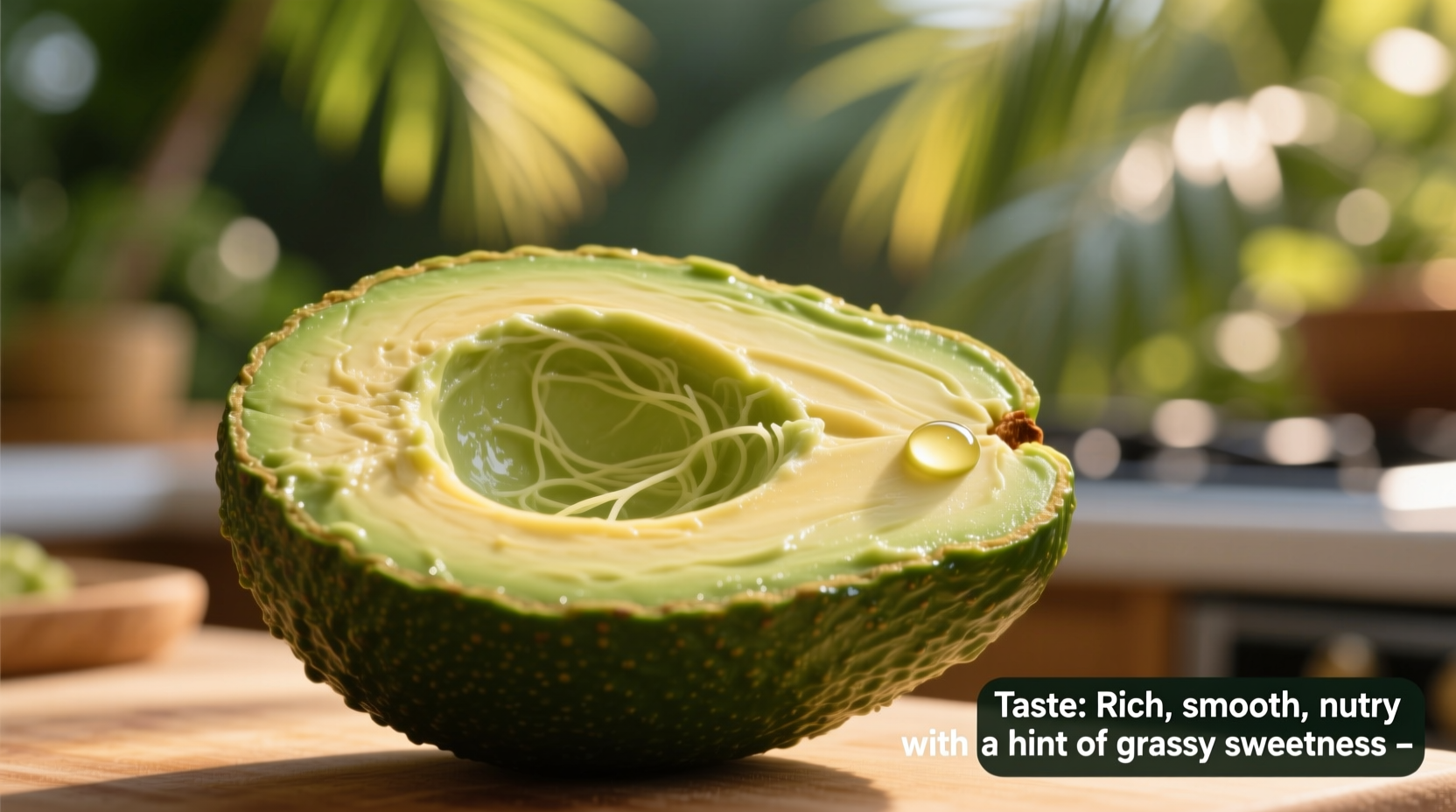Ever wondered what does a avocado taste like when you first try it? You're not alone. This unique fruit confuses many first-time eaters expecting sweetness but finding something entirely different. Understanding avocado's flavor profile helps you appreciate why it's beloved in kitchens worldwide—from guacamole to smoothies.
The Core Flavor Profile: More Than Just “Creamy”
Avocados deliver a mild, neutral base flavor with subtle undertones that change based on ripeness and variety. Unlike tropical fruits bursting with sweetness, avocados offer:
- Buttery richness from their high healthy fat content (monounsaturated fats)
- Earthy, grassy notes reminiscent of fresh herbs
- Delicate nuttiness (especially in Hass varieties)
- Nearly zero sweetness—it's the only fruit with negligible sugar content
This unique combination creates a versatile culinary canvas that absorbs surrounding flavors while adding luxurious texture. Professional chefs value avocados precisely because they don't overpower dishes—they enhance them.
How Ripeness Transforms Flavor (And Why It Matters)
Your avocado's ripeness dramatically impacts its taste experience. Here's what happens chemically as it matures:
| Ripeness Stage | Flavor Characteristics | Texture | Best Uses |
|---|---|---|---|
| Underripe (firm) | Bland, slightly bitter, grassy | Hard, difficult to scoop | Not recommended—wait 2-5 days |
| Perfectly ripe | Creamy, nutty, fresh earthiness | Smooth, spreads easily | Guacamole, salads, toast |
| Overripe | Sour, fermented notes | Brown spots, stringy | Smoothies (if no mold) |
According to USDA agricultural research, avocados develop their characteristic flavor compounds during the ripening process as starches convert to sugars and fats mature. The USDA FoodData Central confirms that ripe avocados contain higher concentrations of volatile compounds responsible for their nutty aroma compared to unripe fruit.

Varietal Differences: Not All Avocados Taste Alike
While Hass dominates 80% of the market, different varieties offer distinct flavor experiences:
- Hass (most common): Pronounced nutty flavor with earthy undertones
- Fuerte: Milder, slightly sweeter with citrus notes
- Bacon: Subtle herbal flavor, less creamy texture
- Reed: Exceptionally smooth with buttery richness
A 2020 study in Food Chemistry analyzed volatile compounds across 12 avocado varieties, confirming Hass contains higher levels of hexanal and (E)-2-hexenal—compounds associated with nutty, green aromas. This explains why many consider Hass the most flavorful variety for standalone consumption.
Why Some People Dislike Avocado (It's Not Just Preference)
About 15% of people report finding avocado unpleasantly bitter. Research from Monell Chemical Senses Center suggests this may relate to genetic variations in taste receptors. Some individuals possess heightened sensitivity to certain compounds in avocados, perceiving flavors others don't detect.
Preparation method also significantly impacts perceived taste. Adding citrus (lemon/lime juice) not only prevents browning but enhances flavor perception by balancing the fat content. Salt draws out subtle nutty notes, while improper storage creates off-flavors.
Practical Flavor Pairing Guide
Maximize avocado's potential with these chef-approved combinations that complement its unique what does a avocado taste like profile:
| Flavor Category | Perfect Pairings | Why It Works |
|---|---|---|
| Acidic | Lime, lemon, vinegar | Cuts through richness, brightens mild flavor |
| Savory | Sea salt, garlic, cilantro | Enhances natural earthiness without overpowering |
| Spicy | Jalapeño, cayenne, black pepper | Creates contrast with creamy texture |
| Umami | Soy sauce, mushrooms, roasted tomatoes | Builds depth in vegetarian applications |
Common Taste Misconceptions Debunked
Myth: “Avocados taste like butter.”
Reality: While texture resembles butter, the flavor is distinctly earthy and fresh—not dairy-like.
Myth: “Ripe avocados should be soft all over.”
Reality: Perfectly ripe avocados yield slightly to gentle pressure near the stem but remain firm elsewhere.
Myth: “All avocados taste the same.”
Reality: Flavor varies significantly by variety and growing conditions—Hass offers the most pronounced nuttiness.
Getting the Best Flavor: Pro Tips
Follow these evidence-based techniques to maximize avocado taste:
- Ripen properly: Store at room temperature in a paper bag with banana/apple to speed ripening via ethylene gas
- Test ripeness correctly: Gently remove stem nub—green underneath means ripe, brown means overripe
- Prevent browning: Coat exposed flesh with citrus juice (not water, which dilutes flavor)
- Season strategically: Salt avocado after cutting to prevent premature breakdown
- Chill before serving: Cold enhances the perception of freshness in ripe avocados
Remember that what does a avocado taste like depends heavily on these preparation factors. A perfectly handled avocado delivers that signature creamy richness with subtle nutty notes that has made it a global favorite.











 浙公网安备
33010002000092号
浙公网安备
33010002000092号 浙B2-20120091-4
浙B2-20120091-4